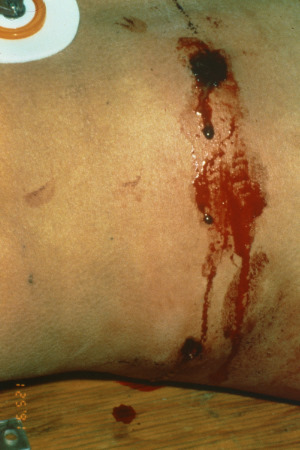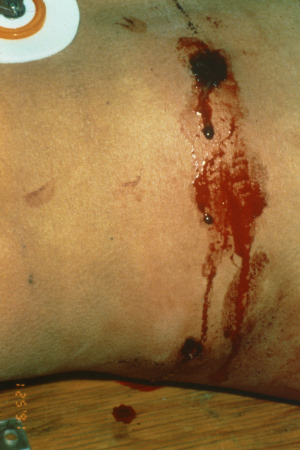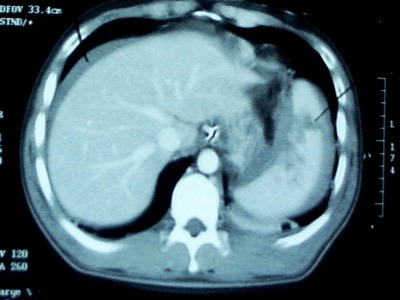There were lots of interesting guesses regarding this photo! Some were very creative, and thought I might be throwing a curve ball. Alas, this was much more straightforward.

What you see is a pair of wounds located just at or slightly above the iliac crest on the right side. If you look carefully, you will see a powder burn around the anterior wound, indicating a close range gunshot. So this would appear to be a run of the mill gunshot to the abdomen; just run to the OR, right?
Not so fast! There are some nuances when dealing with this type of wound. The first things to look at are the vital signs. If they’re not stable, then there is major bleeding present and the patient needs to go to the OR now. Next, do a good exam. As always, stick to the ATLS protocol to make sure you’re not focusing on the abdomen and missing other significant findings. If the abdominal exam is abnormal (tenderness, peritoneal signs) there is either bleeding or contamination and once again it’s time to go to OR. About 98 times out of 100, that’s where you’ll be with a picture like this.
However, if you’ve gotten to this point with none of the above, there is the small possibility that this might be a tangential injury. The flanks (“love handles”) tend to be fairly fatty in some men, especially the obese. And since most civilian gunshots are low velocity, there is less likelihood of deeper injury from blast effect. Local wound exploration is tough in this area due to the amount of fat and the deeper musculature.
My preferred method for evaluating this (rare) type of patient is a quick CT scan of the abdomen and pelvis. The pelvic part is important, because you are looking for obvious penetration and blood in the pelvis. If you see either, it’s time to head to the OR. Very rarely (on the right side) you may see a contusion or superficial laceration of the liver, meaning that there was penetration. However, if there is no possible way the bowel was injured, it is acceptable to closely observe the patient.
Oh, and the board? Back in the day before everything was made of plastic, they actually made backboards out of fairly nice wood!




